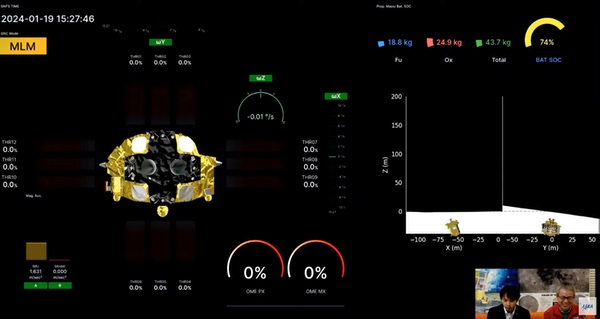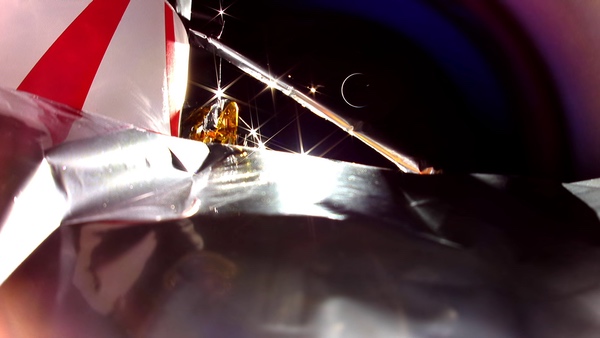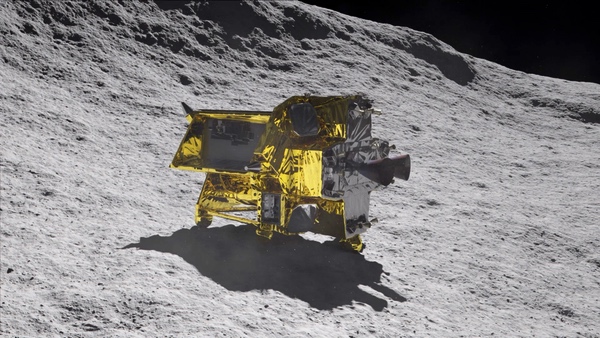The phases of lunar lander successby Jeff Foust
|
| “Now you see on the left-hand side ‘MLM’. That means it has landed,” one of the hosts of the webcast said. There were no scenes of cheering flight controllers or others, though. |
The growing community of agencies and companies developing lunar landers is also grappling with similar issues. Is a mission a success if a spacecraft lands on the lunar surface, only to shut down hours later because of a problem with how it landed? Can a company celebrate and build upon the accomplishments of a mission that fell far short of its goal of landing on the Moon?
The first question arose from Friday’s landing of Japan’s Smart Lander for Investigating Moon (SLIM) mission. The Japan Aerospace Exploration Agency (JAXA) launched SLIM in September, sending it on a low-energy trajectory to minimize propellant consumption. SLIM entered orbit around the Moon on Christmas Day and adjusted that orbit in the following weeks leading up to the landing attempt.
SLIM featured an unconventional design for a lunar lander, a class of spacecraft typified by landing legs extending from a base that has one or more main engines. SLIM has its main engines at one end, but rather than landing legs it had five “shock absorbers,” structures made of an aluminum lattice designed to crush and absorb the force of landing, on one side of the spacecraft. That required SLIM, making its final descent with the main engines pointing down, to carefully tip over to the side with those absorbers just before touching down on the slopes of Shioli Crater.
JAXA’s webcast of the landing showed a telemetry screen rich in detail about the vehicle’s position during its terminal descent, including performance of its thrusters and remaining propellant supplies. The lander appeared to be following its intended path as it swooped up slightly before descending the final few kilometers to the surface, hovering 50 meters above the surface as planned to select a landing site before heading to the surface.
The landing itself was strangely anticlimactic. “Now you see on the left-hand side ‘MLM’. That means it has landed,” one of the hosts of the webcast said through a translator, referring to the telemetry screen. There were no scenes of cheering flight controllers or others, though, and no images or other data from the lander. “It looks like SLIM is on the surface of the Moon,” one of the hosts said a few minutes later. “We are now checking the status.”
That checking of the status continued for several minutes, after which JAXA decided to end the webcast, saying it would provide more information in a press conference. The lack of updates was odd: amateur radio operators reported detecting a signal from SLIM after landing, and NASA’s Deep Space Network was also in contact with the lander. SLIM was on the surface, and appeared to be able to communicate: it seemed like a success.
One hint of a problem was displayed on that telemetry screen: the icons of SLIM on the screen, intended to show its position during its descent, showed it after landing not resting on its five shock absorbers on its side but instead on what might be considered its nose: the side of the lander opposite the main engines. It was as if a tail-dragger plane had been tipped forward so it was resting on its nose and main wheels, rather than main wheels and tail wheel. But with no updates from JAXA, it was unclear of those icons showed an accurate representation of its position or instead were a data artifact.
 A screenshot of telemetry from SLIM after landing suggested it landed in a nose-down orientation. (credit: JAXA) |
Nearly two hours later—well after two in the morning Saturday Japan time—JAXA convened the press conference. Hitoshi Kuninaka, director general of JAXA’s Institute of Space and Astronautical Science (ISAS), offered the good and bad news. “SLIM has been communicating to earth stations and is receiving commands from the Earth accurately, and is responding to these in a normal way,” he said through an interpreter. “However, it seems that the solar cells are not generating electricity at this point in time.”
| “So if sunlight begins to shine on the lunar surface from the west, there is a possibility of generating power, and we are preparing for recovery,” JAXA stated. |
He and other officials said it was unlikely that the solar panels were damaged during landing, since other systems on the spacecraft were working well and showing no signs of damage. Instead, something appeared to be preventing sunlight from reaching the panels, perhaps because the spacecraft had landed in the wrong orientation. But at the press conference officials had few additional details to share.
In social media posts early Monday, the first updates provided by the mission since that press conference, JAXA said telemetry showed that the solar panels were facing west, away from the sun. “So if sunlight begins to shine on the lunar surface from the west, there is a possibility of generating power, and we are preparing for recovery,” it stated.
The spacecraft stopped transmitting about two and a half hours after landing, JAXA said, to conserve its batteries, which were down to 12% at that time. The agency said it was analyzing images and data that SLIM returned during that time, and promised an update on the mission on Thursday.
The landing was hailed as a success by many, with congratulations rolling in from around the world. “Congratulations @JAXA_en on being the historic 5th country to land successfully on the Moon! We value our partnership in the cosmos and continued collaboration with @NASAArtemis,” posted NASA administrator Bill Nelson.
Japan was indeed the fifth nation to softly land a spacecraft on the Moon, after the former Soviet Union, United States, China, and India. But since the spacecraft landed in the wrong orientation, depriving it of power after just a couple hours, some questioned whether the mission should truly qualify as a success.
One guide comes from the press kit JAXA distributed for SLIM, which set out “success criteria” for the mission. What is calls “minimum” success is to “realize a soft landing on the Moon” and verifying the navigation system as well as performance of the spacecraft in orbit before landing. Unless there were problems with the navigation system, SLIM appears to have achieved minimum success despite the orientation problem (akin to the line about any airplane landing you can walk away from being a good landing.)
The press kit also specifies “full” success for the mission, which requires a landing with an accuracy of within 100 meters. SLIM is primarily a technology demonstrator for precision landing, with few scientific instruments on board. As of Monday, JAXA had not disclosed details about the landing precision.
There is ann additional “extra” category of mission success, which includes operating the lander through the end of the two-week lunar day as well as perform unspecified “missions that operate on the lunar surface to obtain knowledge for lunar and planetary surface exploration in the future.” Achieving that extra success now appears doubtful, depending on if and when the solar panels become illuminated. Also uncertain is the status of two small probes dropped off the lander during its final descent.
 One of the final images returned by Peregrine showed the crescent Earth as the lander sped towards reentry. (credit: Astrobotic) |
“Victory after victory” for a failed lander
Even as the JAXA briefing about SLIM was continuing, another media teleconference was getting underway halfway around the world. Astrobotic executives, along with NASA, were providing a postmortem on the Peregrine lander mission. It had launched January 8 but suffered a propellant leak hours after liftoff that ultimately doomed the mission (see “Success and setbacks”, The Space Review, January 8, 2024.)
At the time of that earlier article, it appeared Peregrine’s life would be short: less than a day into the mission, Astrobotic thought there was only enough propellant left to maintain the spacecraft’s attitude for 40 hours. Once the propellant ran out, the spacecraft could no longer keep its solar panels oriented towards the Sun, ending the mission.
| “We were faced with a very difficult decision on what to do with the spacecraft,” Thornton said. |
But engineers at Astrobotic’s Pittsburgh headquarters managed to nurse the mission along, and the company, in a series of refreshingly frequent updates, extended the life of the mission. Three days after launch, the company announced it had turned on power to payloads on the lander, which were returning data. While those payloads were intended to operate on the surface of the Moon, getting some in-flight data was better than nothing.
By the weekend, the propellant leak had slowed and was a diminishing concern. Peregrine has reached lunar distances, although the Moon was not in the vicinity. The mission’s original plan called for Peregrine to swing back around the Earth and then head out to the Moon, going into lunar orbit ahead of a Febeuary 23 landing attempt.
The propellant leak, though, had affected the lander’s orbit, slowing it down and veering it off course slightly, recalled John Thornton, Astrobotic’s CEO. “It changed our trajectory to indicate that, if we did nothing from that point forward, we were very likely to return back to Earth,” he said, burning up in the atmosphere.
Astrobotic then had a choice: try to maneuver the spacecraft to avoid reentry and perhaps keep the mission going a bit longer, including possibly attempt going into lunar orbit (although the company had already ruled out any attempt to land because of the lost propellant) or allow it to reenter and end the mission. “We were faced with a very difficult decision on what to do with the spacecraft,” he said.
Astrobotic decided to take the latter course and allow it to reenter. “It’s important that we all act as responsible parties and make sure that we are keeping space available and accessible for all,” he said, out of concern that performing additional maneuvers to, for example, target a lunar flyby or orbit insertion using its damaged propulsion system “could have possibly caused a catastrophic situation that would potentially create more debris.”
He said Astrobotic consulted with NASA, the biggest customer of Peregrine through its Commercial Lunar Payload Services (CLPS) program, on what to do, suggesting that it agreed with allowing it to reenter. “Peregrine Mission One was Astrobotic’s mission and Astrobotic’s spacecraft, but as one of their big customers, we shared with them our view of the information,” said Joel Kearns, deputy associate administrator for exploration in NASA’s Science Mission Directorate.
Even with the decision to reenter, Astrobotic had to perform additional maneuvers to target that reentry for a region of the South Pacific south of Fiji, minimizing any risk of debris surviving that reentry. That reentry took place around 4 pm EST on Thursday January 18, with no public sightings of the reentry or reports of falling debris.
Peregrine ultimately failed in its mission to land on the Moon, but Astrobotic and NASA did see some value in the flight out to lunar distance and back. The company gained flight experience on other spacecraft systems while NASA collected data from its payloads, such as radiation measurements in cislunar space.
“The data collected in flight sets the stage for understanding how some of our instruments may behave in the harsh environment of space when some of the duplicates fly on future CLPS flights,” said Nicola Fox, NASA associate administrator for science, in a statement.
In the case of Peregrine, NASA and Astrobotic will be able to quantify, financially, the level of partial success of the mission. Thornton said 10% of the overall $108 million NASA CLPS award for the mission was reserved for meeting various mission criteria. “We did not achieve all of the criteria to get all of that 10%, though we did achieve some of those milestones,” such as activating the payloads and demonstrating stable flight in space. “We’re going to continue the conversation with NASA on that one.”
Astrobotic plans to convene a review board, with participation from NASA and outside experts, to investigate the failure. Thornton said the leading hypothesis is that a valve malfunctioned in a helium pressurization system shortly after launch. “It sent a rush of helium down into the oxidizer side,” he said, rupturing the oxidizer tank in a little more than a minute.
That investigation is critical not just for Astrobotic but also for NASA. The agency’s next CLPS mission with the company involves a much larger lander, called Griffin. It will carry NASA’s Volatiles Investigating Polar Exploration Rover (VIPER) mission to the south polar region of the Moon.
| “We want to make sure we really understand the root cause and contributing factors of what happened on Peregrine” before launching VIPER on Griffin, Kearns said. |
VIPER is a key part of NASA’s efforts to understand the extent and accessibility of water ice at the lunar poles that could support later Artemis missions. It’s also an expensive part of the effort, relatively speaking: while Kearns estimated that the NASA payloads on Peregrine cost the agency about $9 million, VIPER has a cost estimate, excluding launch, of $433 million.
Even before Peregrine launched, NASA said it planned to do “enhanced lander testing” on Griffin to give it greater confidence that it would land safely. In Friday’s media call, Kearns said NASA remained committed to keeping VIPER on Griffin, but would proceed with caution.
“VIPER is a very visible, very sophisticated and costly payload,” he said. “We want to make sure we really understand the root cause and contributing factors of what happened on Peregrine.”
That will likely delay the launch, which had been scheduled for November. Thornton said Astrobotic was continuing work on Griffin while awaiting the findings of the Peregrine review board and any changes that they might mean for Griffin. “We do expect some [impact], we just don’t know how much yet,” he said.
Despite not landing on the Moon, Thornton was upbeat about what the company was able to accomplish on Peregrine, saying that customers other than NASA on the mission thanked him for getting the payloads running on the mission. One example he offered was DLR, the German aerospace center, which had a radiation detector on the lander that was able to collect more than 90 hours of what DLR called “extremely valuable” data during the flight.
“We did not achieve the primary objective of landing on the surface of the Moon,” he said. “We had an anomaly, and after that anomaly we just had victory after victory after victory, showing the spacecraft was working in space, showing that the payloads can operate and getting data back from those payloads.”
The space community won’t have long to wait to judge the success, failure, or something in-between for the next lunar lander mission. Intuitive Machines is planning to launch its first lander mission, IM-1, as soon as the middle of February.
Note: we are using a new commenting system, which may require you to create a new account.
